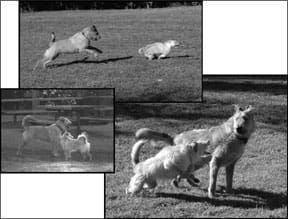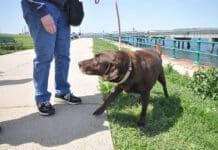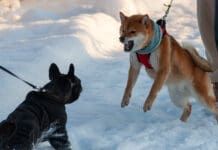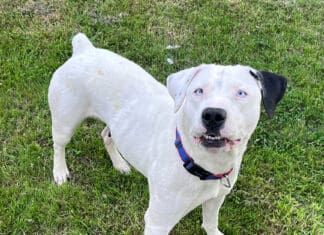Otto has gotten short shrift lately, poor guy. My husband and I had the brilliant idea of undertaking a minor home remodeling project over the holidays – just the bathroom! As is often the case with all-consuming home improvement projects, the dog was left to his own devices more than he should have been for a number of weeks.
Months ago, that would have been a recipe for disaster; Otto would have excavated half the yard and chewed up everything he could have gotten his mouth on. But he must be growing up; even after a few weeks of minor neglect, the only thing he chewed up was one of my husband’s high-top leather work boots. Amazing, considering the number of tools and wood and paintbrushes left lying around.
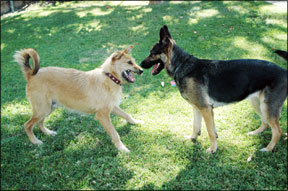
288
He amused himself largely with a new obsession: running along our back fence with our neighbor’s two-year-old German Shepherd Dog, Schotzie. Our lot is about 80 feet wide, and both dogs share a mostly unimpeded path along that entire boundary, with just an ivy-covered five-foot-high chain-link fence between them. They are both young, active, and bored (the neighbors have a new baby). So, up and down they go, thundering through the mud, whining with frustration and excitement. It could be worse; they could be fence-fighting and barking (and maybe, if we remodeled the entire house, it would advance to this). But they seem to enjoy each other. And at least they are both getting exercise!
I’ve tried to talk Schotzie’s owners into letting her come over to play with Otto – and I was successful exactly twice – but they are worried about her “hurting” him. Apparently, on the few occasions when they have taken her someplace where there were other dogs, she “attacked” another dog. She played wonderfully with Otto. But I believe their stories; from what I can observe as a work-at-home neighbor, they hardly ever take her anywhere and she is getting less and less socialized.
It’s frustrating, because I’ve seen this phenomenon several times; in fact, it seems like every time I’ve seen a busy family get a young, big, active dog who hardly ever gets out, the dog’s behavior with other dogs gets worse and worse until they feel they can’t safely take the dog anywhere.
I’ve tried to tactfully describe this syndrome and its possible solutions to Schotzie’s people. They are a young educated couple, and very nice. The mom listens, but the dad appears to have his own strong ideas about dogs and dog training, and I can tell he has to put some effort into politely not-hearing what I have offered.
I get it. Few of us enjoy being subjected to unsolicited advice about our dogs – it’s like having some stranger tell you how you should deal with your toddler when he’s acting out in the supermarket. How likely is it that you could say something like, “Oh, okay! Thanks! I never thought of that!” On the other hand, I can clearly see the impending train wreck that often – usually – results from the social isolation of a large, high-drive dog. So, I’m trying to strike just the right note – respectful, friendly – while casually giving them information to consider.
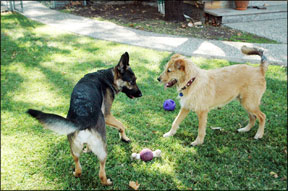
288
Could be the start of a beautiful friendship
A few months ago, Otto and I were just coming in from a bike ride when we saw the neighbors walking Schotzie. The mom had the baby in a front pack; the dad had his hands full with Schotzie, who had recognized her friend (Otto) and was pulling hard to get to him, despite her prong collar. I raced to put Otto and my bike through my front gate, and called to them. “Oh! Hi! Hi Schotzie! Can she come and play? Please?” As the dad looked sort of unconvinced (and Schotzie was going crazy), I pressed on, exaggerating, “Gosh, Otto has been so full of beans, and I’ve tried getting him tired with a bike ride, but he’s just such a handful!” He relented, though he worried out loud, as he was leading Schotzie in the gate as I held Otto back, “I just hope she’s okay. She can be pretty rough!”
“I’m not worried about Otto at all,” I reassured him. And I wasn’t. Otto has really terrific canine language and play skills; I’ve never seen him lose his cool with other dogs. If he gets overwhelmed or bullied, he’ll defend himself with a momentary growl and a snap, but immediately shakes it off and looks for someone else to play with. I’m not taking credit for this; he came equipped with a strong play drive! (Although I do work actively to preserve and protect this trait, by giving him lots of social time with other nice dogs.)
The second the dogs were turned loose, they took off across the yard like meteors. Otto loves being chased, and he had the home field advantage, knowing his yard intimately. Schotzie’s owners and I laughed and thoroughly enjoyed watching the two big dogs joyfully race and leap and wrestle. “Oh, we’ve got to do this again!” I enthused. “This is so great! Look at how happy they are! And they will both really sleep tonight! Thanks so much!”

288
A few days later, I heard the mom calling to Schotzie, as our two dogs once again ran the fenceline. “Hi there!” I called over the fence. “Hey! Can Schotzie come over and play again?” “Sure!” she called back. “That would be great! I’ll bring her over.” The two dogs had even more fun playing this time. I opened my side gates, so they could race from the front yard to the back, and run loops around the house, which they did with delight. I took dozens of pictures of them as they played. They spent about an hour running and wrestling and playing with Otto’s toys.
I was just putting Schotzie’s leash on to take her home when the mom walked up to the front gate to get her. “They had so much fun!” I told her. “Any time you want to tire her out, give me a call; they are really great together! And, oh! Here is an article about why dog play is so good for them.” And I gave her a copy of an issue of WDJ that contains Pat Miller’s brilliant article on the importance of purposeful socialization (“Plays Well With Others,” March 2000).
Was that too pushy? I didn’t think so, but they haven’t taken me up on any further “play date” invitations. Once, while talking to the mom about neighborhood stuff, I asked again if Schotzie could come over and play, and she said, “I’ll have to ask my husband first. We took Schotzie to a picnic recently, and she bit this other dog really badly, and now he’s really concerned about taking her places.”
Argh! I don’t know why it’s so hard to understand that dogs will only get worse without opportunities to socialize, whether they are truly aggressive or, more likely, fear-aggressive. Looking through all the pictures of our two dogs playing, Schotzie’s body language looks anything but aggressive. I suspect she’s had so little experience socializing that she gets scared and overwhelmed and “attacks” out of fear. She didn’t “attack” Otto, perhaps, because she was familiar with him (albeit through the fence) and because he puts out such clearly playful signals; he seems to lack any tendency to bully other dogs.
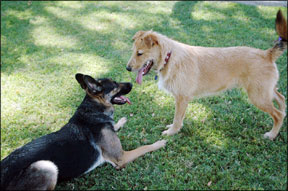
288
Well, at least they have the fenceline. Which, as I said, does actually help tire Otto out, especially when he’s not getting enough walks and hikes.
A trip to town
At the height of the holiday season, we took a few days off from our remodeling project and spent some time with relatives back in the Bay Area. Brian really wanted to leave Otto in Oroville, and have a pet sitter watch over him. But I couldn’t wait for the opportunity to bring Otto to some of my favorite Bay Area doggie hot spots, like the trails in the East Bay Regional Parks, and the dog parks in Alameda and at Point Isabel in Albany. And I really wanted some of my Bay Area friends to get to meet him!
We had a blast! Otto and I took one or two long walks every day, and he got to enjoy some of the best the Bay Area offers a dog, including visits to pet supply stores that offer cookies to canine visitors.
The only part of his “Christmas vacation” that he didn’t really enjoy was the very first part – where I took our often-outdoors dog to a do-it-yourself dog wash, to get him ready for a week of apartment living. He forgave me when I let him pick out a new stuffed squeaky toy to carry out of the store. I also bought him some rawhide chews; I found a place that sells the nicest rawhide chews I’ve ever seen: a roll made from a single “sheet” of extremely thick hide, made by Wholesome Hide. (I’ll be reviewing rawhide chews in the next issue; look for more on what makes a chew “the best rawhide I’ve ever seen” in April.) I didn’t want him chewing up my friends’ and relatives’ stuff while a guest in their homes.

288
As it turned out, he behaved himself like a prince. He was probably too tired to get into too much trouble! He did rearrange many of the shoes in the house where we were staying, when we left him for the longest time. It was Christmas day, and we had dinner at the home of my pet-allergic brother-in-law and his pet-allergic wife. When we came home, we found 12 or 13 shoes, belonging to every member of the household, piled neatly by the front door along with a rawhide.
It was so neat, in fact, that I actually didn’t notice it at first; lots of people leave shoes by their front doors. But when I found one of my sneakers on the pillow of the bed that I had been sleeping in, I investigated further. That’s when I found the other sneaker by the front door, along with lots of other shoes, in pairs and singles. Fortunately, he didn’t chew a single one of them, just carried them about. Given the lack of damage, it was sort of fun, returning everyone’s shoes to their proper places.
The only thing about having Otto “in town” that disappointed me was discovering that we really need to practice walking on-leash more. In Oroville, I only have his leash on for the few blocks that it takes to get to the trailhead where I can walk him off-leash. We work on his leash-walking manners on the way to the trail. On the way home, tired, he’s always perfect on the leash, and though I reward him for this, it’s hardly necessary!
During our stay in the Bay Area, with the exception of his time in a dog park or on our two East Bay Regional Park hikes, he had to be on leash. Whether it was due to anxiety over a new setting, a lack of daily free time in a backyard, or just the sheer number of miles we walked on-leash, he pulled a lot more than he does at home. I carried treats with me, and tried to pay attention and reinforce him when he was walking quietly by my side. But I was walking with friends I hadn’t seen for a while, and talking, and not focusing exclusively on Otto. It’s time to go back to class, I guess.
Socializing with city dogs
At least once a week, I take Otto to a dog-park-like setting in the nearby town of Chico, California. It’s actually a genetic resource and conservation center for the Mendocino National Forest; it’s where they grow trees that produce the seeds used to replant forests. The best part is that it’s 200 fenced acres where people are allowed to walk their dogs off-leash. There is even a creek that runs through the middle of it, and dogs are welcome to splash through and swim in it. It’s awesome.
Many area dog owners take their dogs there for exercise and socialization, but it lacks the insular, intense feel that some crowded, urban dog parks can have. Mostly, dog owners walk a trail on the perimeter of the property. When you encounter dogs and people going the other way, or you pass somebody, it’s customary to allow the dogs to greet and play for a few minutes, and then walk on. Every so often, you meet another dog with the exact same play style and interest in playing that your dog does, and you might linger with them a good bit longer, or even walk the perimeter with them. It’s very relaxed and spacious – and I’ve noticed that the environment really promotes relaxed and happy dogs. I’ve never seen a dog fight there, or heard a dog owner screaming at another dog owner.
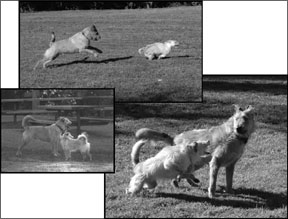
288
I wish I could say the same for urban dog parks. I’ve been there and seen that before; Otto hadn’t, and he was a bit overwhelmed. On his first day at a two-acre park, a huge black dog (a Puli-mix, maybe?) repeatedly rushed him in a fairly intense manner, barking loudly, and he wouldn’t stop even when Otto dodged and bowed playfully. He only stopped when Otto ran 30 yards away or so.
Otto looked a bit mystified, but shook it off to find other playmates. In five trips to that park, though, he only found one dog that he really got into playing with, a young Husky female who was just as into chasing and bouncing games as he was. Many of the dogs were obsessed with fetching and couldn’t be bothered, or were older and grumpy. And a few were bullies! Like the big black dog, they seemed intent on rushing over to new dogs and inflicting their stamp of dominance on them. Otto would kind of hold his ground, neither rolling over submissively nor giving back any resistance, but as soon as he was “released,” or another dog approached to distract the bully, he’d hightail it for someplace else.
He had the same reaction at another, larger (but if anything, even more densely populated) dog park, when he heard a dog owner screaming at another dog owner after a bit of a scuffle involving half a dozen dogs. He had rushed toward the scuffle, getting there just as it broke up, and then looked plain astonished when the people started yelling at each other. Whoa! He gave them the same look he had given the big black dog and ran back toward me. I probably had the same expression on my face! Yikes! Let’s get out of here!
Seriously, I kept these urban dog park trips short; I could see they were a bit overstimulating after 20 minutes or so. Otto’s eyes would get a glazed look, and his tongue would look pasty and dry, even after drinking. He’d still be running around, but not in a joyous, bouncy way; he looked kind of hunted and distracted, even if no dog was chasing him. That was my signal to call him back and leave the park.
The most fun Otto had “on vacation” was during the two off-leash hikes we took with my friend Sandi Thompson (a Berkeley-based trainer who often models for our training articles) and her dog, Turtle (that’s them on pages 3-5). Turtle looks like a Mini-Me of Otto, a smaller, blonder, nimbler terrier-mix with an oversized ego and sense of humor. Otto found her fascinating, if a bit challenging. I’ll leave you with photos of their playtime together. His dismayed expression in the last one makes me laugh out loud every time I see it!
Nancy Kerns is Editor of WDJ. She and her husband adopted Otto from a shelter on June 13, 2008.


